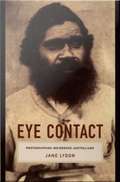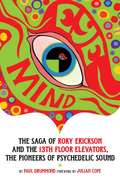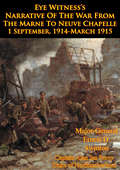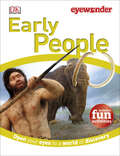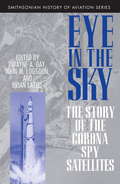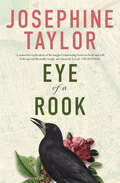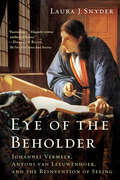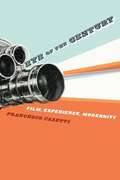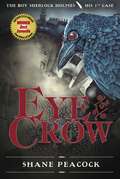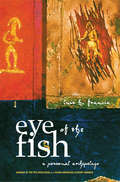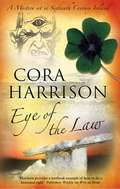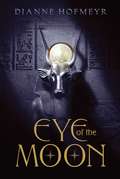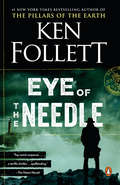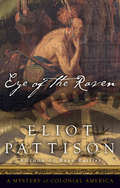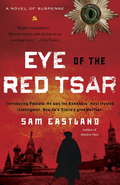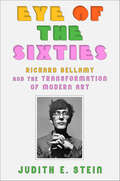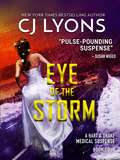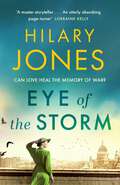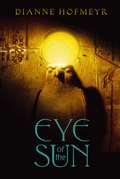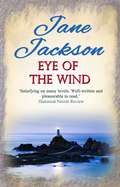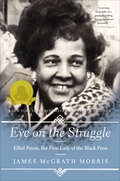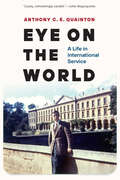- Table View
- List View
Eye Contact: Photographing Indigenous Australians
by Jane LydonAn indigenous reservation in the colony of Victoria, Australia, the Coranderrk Aboriginal Station was a major site of cross-cultural contact the mid-nineteenth century and early twentieth. Coranderrk was located just outside Melbourne, and from its opening in the 1860s the colonial government commissioned many photographs of its Aboriginal residents. The photographs taken at Coranderrk Station circulated across the western world; they were mounted in exhibition displays and classified among other ethnographic "data" within museum collections. The immense Coranderrk photographic archive is the subject of this detailed, richly illustrated examination of the role of visual imagery in the colonial project. Offering close readings of the photographs in the context of Australian history and nineteenth- and early-twentieth-century photographic practice, Jane Lydon reveals how western society came to understand Aboriginal people through these images. At the same time, she demonstrates that the photos were not solely a tool of colonial exploitation. The residents of Coranderrk had a sophisticated understanding of how they were portrayed, and they became adept at manipulating their representations. Lydon shows how the photographic portrayals of the Aboriginal residents of Coranderrk changed over time, reflecting various ideas of the colonial mission--from humanitarianism to control to assimilation. In the early twentieth century, the images were used on stereotypical postcards circulated among the white population, showing what appeared to be compliant, transformed Aboriginal subjects. The station closed in 1924 and disappeared from public view until it was rediscovered by scholars years later. Aboriginal Australians purchased the station in 1998, and, as Lydon describes, today they are using the Coranderrk photographic archive in new ways, to identify family members and tell stories of their own.
Eye Mind
by Paul Drummond Julian Cope"One of the most exhilarating and important rock 'n' roll stories ever told."--Julian CopeThe trailblazing 13th Floor Elevators released the first "psychedelic" rock album in America, transforming culture throughout the 1960s and beyond. The Elevators followed their own spiritual cosmic agenda, to change society by finding a new path to enlightenment. Their battles with repressive authorities in Texas and their escape to San Francisco's embryonic counterculture are legendary.When the Elevators returned to Texas, the band became subject to investigation by Austin police. Lead singer Roky Erickson was forced into a real-life enactment of One Flew over the Cuckoo's Nest and was put away in a maximum-security unit for the criminally insane for years. Tommy Hall, their Svengali lyricist, lived in a cave. Guitarist Stacy Sutherland was imprisoned. The drummer was involuntarily subjected to electric shock treatments, and the bassist was drafted into the Vietnam War.This fascinating biography breaks decades of silence of band members and addresses a huge cult following of Elevators fans in the United States and Europe. The group is revered as a formative influence on Janis Joplin, Led Zeppelin, Patti Smith, Primal Scream, R.E.M, and Z.Z. Top.Roky Erickson is the subject of a heralded recent documentary feature, You're Gonna Miss Me; a box set of remastered Elevators CDs with liner notes by author Paul Drummond will be issued in fall 2007.
Eye Witness’s Narrative Of The War From The Marne To Neuve Chapelle 1 September, 1914-March 1915 [Illustrated Edition]
by Major-General Ernest D. Swinton Captain Alan Ian Percy Duke of NorthumberlandIncludes The First World War On The Western Front 1914-1915 Illustrations Pack with 101 maps, plans, and photos.Major-General Ernest Swinton had already had a long and illustrious career in the British Army before the advent of the First World War in 1914. Appointed as the official war correspondent by the war Minister Lord Kitchener in 1914, his reporting home was the only way for the British people to follow the war as journalists were at that time banned at the front. In these dispatches from the front Swinton told the public of the bloody fighting in Flanders and the heroic efforts of the Allies to stop the German Juggernaut. So even handed and realistic they were brought together in a series of books under the pseudonym "Eyewitness" for further publication. Swinton was not a "château" general by any means and visited the front with dangerous regularity write of the fighting with real authority, often including anecdotes of the ordinary soldiers that he interviewed. The miserable conditions and bloody siege warfare of the trenches left a lasting impression on him and he looked to a scientific solution to the muddy stalemate of the Western Front. He would gain lasting fame as the architect of the "tank" project that was to revolutionize warfare in the First World War and for many years thereafter.
Eye Wonder: Open Your Eyes to a World of Discovery (Eye Wonder)
by DKWhat was life like for early people before written records even began? Satisfy your child's curiosity about the lives of some of the first people with Eye Wonder: Early People. From the earliest human-like apes to the use of stone-age tools, from the discovery of fire to the dawn of agriculture and civilization, this book explores how the earliest people lived. This new addition features fun activities to help your child learn and remember the information in Eye Wonder: Early People. Visual learners and readers alike will love exploring and learning through Eye Wonder: Early People. These books are designed to teach through pictures and a visual approach, encouraging curiosity in young, school-age children. We've added games, activities, and quizzes to engage children even more — Eye Wonder: Early People activities are designed to teach kids to both remember more of what they've learned, and learn to research when they want to know more, teaching general study skills as well as knowledge about early people. Learn about science, history, and the natural world through beautiful photography and lively, age-appropriate text. The Eye Wonder series organizes information in a way that's easy to search, easy to read, and easy to learn.
Eye in the Sky
by Dwayne DayPresenting the full story of the CORONA spy satellites' origins, Eye in the Sky explores the Cold War technology and far-reaching effects of the satellites on foreign policy and national security. Arguing that satellite reconnaissance was key to shaping the course of the Cold War, the book documents breakthroughs in intelligence gathering and achievements in space technology that rival the landing on the moon.
Eye of a Rook
by Josephine TaylorIn 1860s London, Arthur sees his wife, Emily, suddenly struck down by a pain for which she can find no words, forced to endure harmful treatments and reliant on him for guidance. Meanwhile, in contemporary Perth, Alice, a writer, and her older husband, Duncan, find their marriage threatened as Alice investigates the history of hysteria, female sexuality and the treatment of the female body – her own and the bodies of those who came before.
Eye of the Beholder: Johannes Vermeer, Antoni van Leeuwenhoek, and the Reinvention of Seeing
by Laura J. SnyderThe remarkable story of how an artist and a scientist in seventeenth-century Holland transformed the way we see the world. On a summer day in 1674, in the small Dutch city of Delft, Antoni van Leeuwenhoek--a cloth salesman, local bureaucrat, and self-taught natural philosopher--gazed through a tiny lens set into a brass holder and discovered a never-before imagined world of microscopic life. At the same time, in a nearby attic, the painter Johannes Vermeer was using another optical device, a camera obscura, to experiment with light and create the most luminous pictures ever beheld. "See for yourself!" was the clarion call of the 1600s. Scientists peered at nature through microscopes and telescopes, making the discoveries in astronomy, physics, chemistry, and anatomy that ignited the Scientific Revolution. Artists investigated nature with lenses, mirrors, and camera obscuras, creating extraordinarily detailed paintings of flowers and insects, and scenes filled with realistic effects of light, shadow, and color. By extending the reach of sight the new optical instruments prompted the realization that there is more than meets the eye. But they also raised questions about how we see and what it means to see. In answering these questions, scientists and artists in Delft changed how we perceive the world. In Eye of the Beholder, Laura J. Snyder transports us to the streets, inns, and guildhalls of seventeenth-century Holland, where artists and scientists gathered, and to their studios and laboratories, where they mixed paints and prepared canvases, ground and polished lenses, examined and dissected insects and other animals, and invented the modern notion of seeing. With charm and narrative flair Snyder brings Vermeer and Van Leeuwenhoek--and the men and women around them--vividly to life. The story of these two geniuses and the transformation they engendered shows us why we see the world--and our place within it--as we do today.
Eye of the Century: Film, Experience, Modernity (Film and Culture Series)
by Francesco CasettiIs it true that film in the twentieth century experimented with vision more than any other art form? And what visions did it privilege? In this brilliant book, acclaimed film scholar Francesco Casetti situates the cinematic experience within discourses of twentieth-century modernity. He suggests that film defined a unique gaze, not only because it recorded many of the century's most important events, but also because it determined the manner in which they were received.Casetti begins by examining film's nature as a medium in an age obsessed with immediacy, nearness, and accessibility. He considers the myths and rituals cinema constructed on the screen and in the theater and how they provided new images and behaviors that responded to emerging concerns, ideas, and social orders. Film also succeeded in negotiating the different needs of modernity, comparing and uniting conflicting stimuli, providing answers in a world torn apart by conflict, and satisfying a desire for everydayness, as well as lightness, in people's lives. The ability to communicate, the power to inform, and the capacity to negotiate-these are the three factors that defined film's function and outlook and made the medium a relevant and vital art form of its time.So what kind of gaze did film create? Film cultivated a personal gaze, intimately tied to the emergence of point of view, but also able to restore the immediacy of the real; a complex gaze, in which reality and imagination were combined; a piercing gaze, achieved by machine, and yet deeply anthropomorphic; an excited gaze, rich in perceptive stimuli, but also attentive to the spectator's orientation; and an immersive gaze, which gave the impression of being inside the seen world while also maintaining a sense of distance. Each of these gazes combined two different qualities and balanced them. The result was an ever inventive synthesis that strived to bring about true compromises without ever sacrificing the complexity of contradiction. As Casetti demonstrates, film proposed a vision that, in making opposites permeable, modeled itself on an oxymoronic principle. In this sense, film is the key to reading and understanding the modern experience.
Eye of the Crow: His 1st Case) (The Boy Sherlock Holmes #1)
by Shane PeacockSherlock Holmes, just thirteen, is a misfit. His highborn mother is the daughter of an aristocratic family, his father a poor Jew. Their marriage flouts tradition and makes them social pariahs in the London of the 1860s; and their son, Sherlock, bears the burden of their rebellion. Friendless, bullied at school, he belongs nowhere and has only his wits to help him make his way.But what wits they are! His keen powers of observation are already apparent, though he is still a boy. He loves to amuse himself by constructing histories from the smallest detail for everyone he meets. Partly for fun, he focuses his attention on a sensational murder to see if he can solve it. But his game turns deadly serious when he finds himself the accused -- and in London, they hang boys of thirteen.Shane Peacock has created a boy who bears all the seeds of the character who has mesmerized millions: the relentless eye, the sense of justice, and the complex ego. The boy Sherlock Holmes is a fascinating character who is sure to become a fast favorite with young readers everywhere.From the Hardcover edition.
Eye of the Fish
by Luis H. FranciaThe first of Luis H. Francia's books of non-fiction to be published in the United States, The Eye of the Fish paints a vivid and detailed portrait of the terror, beauty and insistent humanity of the Philippines of today. <p><p> Cross-cutting between Francia's recollections of the Philippines of his youth and accounts of his travels through the archipelago over the past two decades, The Eye of the Fish takes us the length of the nation: from Batanes in the north to the Muslim Jolo and Marawi regions of the south, and from the rugged mountain hideaways of revolutionary freedom fighters to the well-appointed salons of the political and cultural elite. Painters and priests, island shamans and small-town politicians, cultists, feminists and infamous first ladies all make an appearance in this imaginative and idiosyncratic exploration of 'home.' <p> Through their stories, and through his own memories of estrangement and acceptance in the Philippines and in the U.S., Francia reflects on the hybridity that is simultaneously the burden and the benediction of the Philippines--and of his own mestizo self.
Eye of the Hawk
by David William RossIN THE SPELLBINDING TRADITION OF LONESOME DOVE AND STREETS OF LAREDO A MAGNIFICENT SAGA OF LIFE AND DEATH IN THE LONE STAR REPUBLIC It was a harsh and inhospitable land, claimed by many yet owned by none. Here Comanche and Kiowa joined together in terror and brutality to halt a young nation's relentless march westward...dangerous banditos roamed open plains...and runaway slaves reached for freedom. And it was here that Seth Redmond brought his wife Isabelle to raise a family and to build a dream called Thunder Run-a dream that would endure through two generations of cruelty, lust, betrayal and dark secrets ... and the crazed blood vengeance of a fearsome warrior chief.
Eye of the Law: A Mystery of Medieval Ireland (Burren Mysteries #5)
by Cora HarrisonA Mystery of Medieval Ireland--1510. A great feast is being held. Into a crowd listening to the story of Balor, the one-eyed god, come two strangers. The younger of the two, Iarla, bears a letter that claims that the wealthy Ardal O'Lochlainn is his true father--which Ardal vociferously denies. So when Iarla is found dead, with one eye missing, some think he was killed by the god--but most suspect Ardal. Mara, the Brehon--or lawgiver--of the Burren, is called to investigate.
Eye of the Moon
by Dianne HofmeyrIsikara and her father tend the sacred crocodiles and assist at mummifications of both humans and animals. One day, they are ordered to a tomb. Two bodies are waiting for them--Queen Tiy and her eldest son, Tuthmosis. Tuthmosis has been poisoned but is clinging to life. With no time to spare, Isikara rescues the young prince and runs away with him. The pair find themselves on a journey across Egypt, searching for allies who will help Tuthmosis regain his throne. Their travels lead them along the Nile, across the desert, and through bustling market towns. All the while they must avoid their pursuers, the High Priests who wish to silence them. But there are dangers in the desert and all around. Who can they trust? And where will their adventure lead them? In this gripping tale, published for the first time in the U.S., author Dianne Hofmeyr spins a web of intrigue, mystery and adventure, woven throughout with fascinating historical details about Ancient Egypt.
Eye of the Needle: A Novel
by Ken FollettThe worldwide phenomenon from the author of Edge of Eternity.His code name was "The Needle." He was a German aristocrat of extraordinary intelligence--a master spy with a legacy of violence in his blood, and the object of the most desperate manhunt in history.... But his fate lay in the hands of a young and vulnerable English woman, whose loyalty, if swayed, would assure his freedom--and win the war for the Nazis....From the Paperback edition.
Eye of the Raven: A Mystery of Colonial America (The Mystery of Colonial America Series #2)
by Eliot PattisonWith the aid of the Indian Shaman Conawago, Duncan McCallum has begun to heal from the massacre of his Highland clan by the British. But his new life is shattered when he and Conawago discover a dying Virginian officer nailed to an Indian shrine tree. To their horror, the authorities arrest Conawago and schedule his hanging. As Duncan begins a desperate search for the truth, he finds himself in a maelstrom of deception and violence. The year is 1760, and while the British army wishes to dismiss the killing as another casualty of its war with France, Duncan discovers a pattern of ritualistic murders that have less to do with the war than with provincial treaty negotiations and struggles between tribal factions. Ultimately he realizes that to find justice, he must brave the sprawling colonial capital of Philadelphia. There the answers are to be found in a tangle of Quakers, Christian Indians, and a scientist obsessed with the electrical experiments of the celebrated Dr. Franklin. With the tragic resolution in sight, Duncan understands the real mysteries underlying his quest lie in the hearts of natives who, like his Highland Scots, have glimpsed the end of their world approaching.
Eye of the Red Tsar: A Novel of Suspense
by Sam EastlandIn a remarkable debut with the chilling atmosphere of "Gorky Park" and the historical paranoia of "Child 44," a brilliant secret agent is brought back from the brink of civilization to solve the very crime that put him there.
Eye of the Red Tsar: A Novel of Suspense
by Sam EastlandBONUS: This edition contains an excerpt from Sam Eastland's Shadow Pass.Shortly after midnight on July 17, 1918, the imprisoned family of Tsar Nicholas Romanov was awakened and led down to the basement of the Ipatiev house. There they were summarily executed. Their bodies were hidden away, the location a secret of the Soviet state. A decade later, Pekkala, once the most trusted secret agent of the Romanovs, is now Prisoner 4745-P, banished to a forest on the outskirts of humanity. But the state needs Pekkala one last time. His mission: catch the assassins who slaughtered the Romanovs, locate the royal child rumored to be alive, and give Stalin the international coup he craves. Find the bodies, Pekkala is told, and you will find your freedom. In a land of uneasy alliances and lethal treachery, pursuing clues that have eluded everyone, Pekkala is thrust into the past where he once reigned. There he will meet the man who betrayed him and the woman he loved and lost in the fires of rebellion—and uncover a secret so shocking that it will shake to its core the land he loves.
Eye of the Sixties: Richard Bellamy and the Transformation of Modern Art
by Judith E. SteinIn 1959, Richard Bellamy was a witty, poetry-loving beatnik on the fringe of the New York art world who was drawn to artists impatient for change. By 1965, he was representing Mark di Suvero, was the first to show Andy Warhol’s pop art, and pioneered the practice of “off-site” exhibitions and introduced the new genre of installation art. As a dealer, he helped discover and champion many of the innovative successors to the abstract expressionists, including Claes Oldenburg, James Rosenquist, Donald Judd, Dan Flavin, Walter De Maria, and many others. The founder and director of the fabled Green Gallery on Fifty-Seventh Street, Bellamy thrived on the energy of the sixties. With the covert support of America’s first celebrity art collectors, Robert and Ethel Scull, Bellamy gained his footing just as pop art, minimalism, and conceptual art were taking hold and the art world was becoming a playground for millionaires. Yet as an eccentric impresario dogged by alcohol and uninterested in profits or posterity, Bellamy rarely did more than show the work he loved. As fellow dealers such as Leo Castelli and Sidney Janis capitalized on the stars he helped find, Bellamy slowly slid into obscurity, becoming the quiet man in oversize glasses in the corner of the room, a knowing and mischievous smile on his face.Born to an American father and a Chinese mother in a Cincinnati suburb, Bellamy moved to New York in his twenties and made a life for himself between the Beat orbits of Provincetown and white-glove events like the Guggenheim’s opening gala. No matter the scene, he was always considered “one of us,” partying with Norman Mailer, befriending Diane Arbus and Yoko Ono, and hosting or performing in historic Happenings. From his early days at the Hansa Gallery to his time at the Green to his later life as a private dealer, Bellamy had his finger on the pulse of the culture. Based on decades of research and on hundreds of interviews with Bellamy’s artists, friends, colleagues, and lovers, Judith E. Stein’s Eye of the Sixties rescues the legacy of the elusive art dealer and tells the story of a counterculture that became the mainstream. A tale of money, taste, loyalty, and luck, Richard Bellamy’s life is a remarkable window into the art of the twentieth century and the making of a generation’s aesthetic.--"Bellamy had an understanding of art and a very fine sense of discovery. There was nobody like him, I think. I certainly consider myself his pupil." --Leo Castelli
Eye of the Storm (Hart and Drake Medical Suspense #4)
by CJ LyonsA kidnapping threatens the Christmas wedding of an ER doctor and a detective in this romantic suspense thriller by the bestselling author of Face to Face.After all that they’ve been through, no one would deny that Hart and Drake deserve a happily-ever-after life together.But, on the eve of their Christmas wedding, a threat long buried returns to threaten them. Not just their happiness, not only their lives, but everything they hold dear.Separated and desperate to save each other, untangling a knot of mystery dating back to Hart’s Gram Rosa’s fight against the Nazis, and facing an enemy unlike any they’ve encountered before, both Hart and Drake must search their hearts to find the strength to survive.An unforgettable finale for an unforgettable couple who prove that two wounded souls have the power to save each other . . .Praise for the Hart and Drake series“A perfect blend of romance and suspense. My kind of read.” —Sandra Brown, #1 New York Times–bestselling author“Tensions sizzle in this hot new medical thriller by CJ Lyons. Think you know what’s going to happen next? Guess again.” —Lisa Gardner, New York Times–bestselling author “Pulse-pounding suspense and hair-raising chills . . . a story of danger and intrigue that defies any reader to put it down.” —Susan Wiggs, New York Times–bestselling author “A page-turner of a story. Nerves of Steel is taut, gripping and nonstop. Don't miss it!” —Carla Neggers, New York Times–bestselling author
Eye of the Storm: 'An utterly absorbing page-turner' Lorraine Kelly
by Hilary JonesA DEVASTATING WAR. A LOVE THAT WON'T DIE.A sweeping and sumptuous historical epic from Hilary Jones. The 1918 armistice has ended the war in Europe. But as the 1920's roars to life, it is an age of social change, excess, shellshock and ghosts.Having shown courage and strength on the battlefield, Will and Grace are back in the UK and working at the cutting edge of modern medicine. At every turn they see a country in flux.Many of their contemporaries are following serious paths, committing to causes of the day – workers' rights, votes for women, an independent Ireland.Others seek refuge in more earthly and bohemian pleasures. But as young parents and practising medics, they have – more than anything – duties of care and compassion that cannot be ignored.The follow-up to Hilary Jones's acclaimed debut novel, Frontline, perfect for fans of Ken Follett, Kate Mosse and Jeffrey Archer. ___________PRAISE FOR DR HILARY JONES'The doctor hits the spot and deserves to be read' - Jeffrey Archer'A story to get the heart racing' - Daily Express'An enthralling tale' - Daily Mirror'Dr Hilary is a master storyteller' - Lorraine Kelly CBE
Eye of the Storm: 'An utterly absorbing page-turner' Lorraine Kelly
by Hilary JonesA DEVASTATING WAR. A LOVE THAT WON'T DIE.A sweeping and sumptuous historical epic from Hilary Jones. The 1918 armistice has ended the war in Europe. But as the 1920's roars to life, it is an age of social change, excess, shellshock and ghosts.Having shown courage and strength on the battlefield, Will and Grace are back in the UK and working at the cutting edge of modern medicine. At every turn they see a country in flux.Many of their contemporaries are following serious paths, committing to causes of the day – workers' rights, votes for women, an independent Ireland.Others seek refuge in more earthly and bohemian pleasures. But as young parents and practising medics, they have – more than anything – duties of care and compassion that cannot be ignored.The follow-up to Hilary Jones's acclaimed debut novel, Frontline, perfect for fans of Ken Follett, Kate Mosse and Jeffrey Archer. ___________PRAISE FOR DR HILARY JONES'The doctor hits the spot and deserves to be read' - Jeffrey Archer'A story to get the heart racing' - Daily Express'An enthralling tale' - Daily Mirror'Dr Hilary is a master storyteller' - Lorraine Kelly CBE
Eye of the Sun
by Dianne HofmeyrIn this exciting sequel to Eye of the Moon, Tuthmosis's brother, Amenhotep, struggles with the priests and his power-hungry young wife, Nefertiti. Ta Miu, who helped Tuthmosis and Isikara escape in Eye of the Moon, is now maidservant to Nefertiti's rival, Kiya. But when Ta Miu falls for tomb-robber, Samut, she finds herself imprisoned. Meanwhile Tuthmosis and Isikara return from Egypt in secret, sending rumours flying about the prince's intentions. Nefertiti is terrified that he is after her husband's throne, while the High Priest fears his secret will be revealed. Their hiding place betrayed by Samut, Isikara is captured and thrown into prison alongside Ta Miu, and Tuthmosis is murdered. Only Ta Miu and Isikara know the truth and unless they can escape, the guilty will go free...
Eye of the Wind
by Jane JacksonMeticulously-researched...warming the hearts of millions of readers.' Historical Novels Review 'Collier has a gift for bringing her characters to life that will keep the reader engrossed until the end' Daily Mail A new Saga Queen hits the televisual cobbles- Daily Telegraph Book Six in the Brothers and Lovers series by best-selling author Catrin Collier Judy Hamilton was born in the Cardiff docklands. Homeless after the death of her grandmother, she finds friendship, work and lodgings with Edyth Slater, above her bakery in Cardiff's colourful Tiger Bay. While attempting to make her way in a vibrant and complex society, Judy dreams of one day becoming a successful singer and actress. Restless and anxious to make his fortune, David Ellis leaves his brothers and sisters behind him on their isolated Breconshire farm. He is ready to embark on a new, more exciting life and is willing to do whatever it takes to find success. The enterprising natives of Tiger Bay manage to make a living from those rich enough to remain unscathed by the depression of the 1930s. Flouting the law, they open illegal casinos and nightclubs to cater for those who can still afford a good time. None are more ruthless than Aled James. With Aled's help, Judy finally breaks into the glittering paste and cardboard world of the city's nightclubs and theatres, but Aled demands a high price for his assistance. David and Judy soon discover that even with a pocketful of money, the life they'd dreamed about may come at too high a price...
Eye on the Struggle: Ethel Payne, the First Lady of the Black Press
by James McGrath Morris[An] important and often absorbing new book . . . It’s a deep pleasure to meet Ethel Payne. ‘We are soul folks,’ she declared in 1967, ‘and I am writing for soul brothers’ consumption.’ Her own soul beams from this book. — New York Times“A riveting biography of a groundbreaking African American journalist . . . In James McGrath Morris’s compelling biography Eye on the Struggle, this ‘first lady of the black press’ finally gets her due.” — O, the Oprah Magazine“Morris’s research on Payne is meticulous…” — Washington Post“[A] beautifully written and carefully researched new book.” — Chicago Tribune“Afast-paced tour through the highlights of 20th-century African-American history, with Payne as witness.” — Boston Globe“It is through Payne’s eyes that author James McGrath Morris deftly shows us the history of post-World War II America.” — Minneapolis Star Tribune“…James McGrath Morris lifts Ethel Payne from relative obscurity revealing a fearless, intrepid journalist who covered practically every important event of her day…” — Herb Boyd, National Association of Black Journalist, Hall of Fame, inducteeEthel Payne was a pioneer who experienced the challenges but little of the glory that comes with the title. With this book, her legacy is assured. — Paula J. Giddings, author of Ida, A Sword Among Lions: Ida B. Wells and the Campaign Against Lynching“A deeply researched, skillfully written biography about a previously underappreciated individual.” — Kirkus Reviews“James McGrath Morris’s eloquent book - quite a feat of historical excavation into the black press as well - should bring her many new admirers.” — Wil Haygood, author of the bestselling,The Butler: A Witness to HistoryIn Eye on the Struggle James McGrath Morris lifts Ethel Payne from relative obscurity revealing a fearless, intrepid journalist who covered practically every important event of her day, whether at home in the heat of the civil rights movement or traveling abroad to Africa and Asia. ” — Herb Boyd, author of Brotherman and Baldwin's Harlem“Eye on the Struggle is an incredibly important act of historical recovery. James McGrath Morris’ penetratingly insightful biography of Ethel Payne takes us into the world of the civil rights era black press through the eyes of one its trailblazing journalists.” — Peniel E. Joseph, author of Waiting Til the Midnight Hour and Stokely Peniel E. Joseph, author of Waiting Til the Midnight Hour and Stokely “A debt of gratitude is due James McGrath Morris for bringing the remarkable life of Ethel Payne out of the shadows.” — Pamela Newkirk, author of,Spectacle: The Astonishing Life of Ota BengaThe rich use of sources and glimpses of Payne’s personal life will engage readers interested in civil rights, journalism, and women’s history.” — Library Journal“Besides reclaiming an important figure in American journalism, Eyes on the Struggle offers historical context for the journalistic role that alternative media play in current civil rights movements. . . His quest not only recounts a storied life but also reminds readers of the historic centrality of alternative media in social change.” — Journal of American History“A well-researched, detailed look at the life of a pioneering journalist.” — The Washington Independent Review of Books“[A] groundbreaking biography” — KamWilliams.com“Morris is not only insightful, but also wise…” — Dallas Morning News“Morris has written a fast-paced, engrossing biography…” — New York Times Book Review“Biographer James McGrath Morris pulls back the curtain o
Eye on the World: A Life in International Service
by Anthony C. QuaintonEye on the World is the autobiography of diplomat Anthony C. E. Quainton, the story of a long and varied life lived in eleven countries on six continents. Rather than a formal history, this is Quainton&’s reflection on his interactions with the events of those times, beginning with George VI&’s historic visit to North America in 1939, through the years of the Cold War, the efforts to contain and then defeat the Soviet Union, and finally the two decades of uneasy peace that came after the fall of the Berlin Wall. To some of these events Quainton was merely a spectator. In other areas––India, Nicaragua, Kuwait, and Peru––he was actively involved either as a participant in the policy process in Washington or as the senior representative of the United States in those countries. Spanning his upbringing and education through two decades after his retirement, Quainton describes the expanding horizons of a middle-class boy from the northwest corner of North America as he encountered the complexity of the world in which he spent his professional life. Quainton served in seven different presidential appointments under presidents Gerald Ford, Jimmy Carter, Ronald Reagan, George H. W. Bush, and Bill Clinton. These included four ambassadorships in distinct parts of the world and three assistant secretary–level posts in Washington. This range of geographic and functional assignments was unique in his generation of Foreign Service officers.
